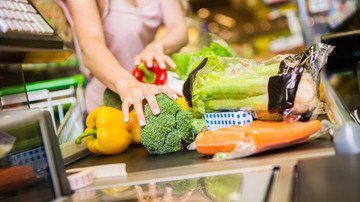This article was originally published by Willow Tohi at Natural News.
-
- Trump’s 10% tariffs on imports are driving up food costs, particularly for staples like avocados, berries, and nuts. Economists warn that higher tariffs (25%+) could make healthy produce unaffordable for many families.
-
- Importers are passing tariff costs directly to consumers, hurting low-income households. Mexican avocados (96% of U.S. imports) could spike by 10–20%, pricing them out for some.
-
- Agricultural sectors face higher wages due to immigration crackdowns, leading to worker shortages and potential crop losses. Domestic produce prices may rise by 15-20%.
-
- Tariffs undermine heart-healthy diets, worsening obesity and diabetes. Food deserts expand as fresh foods become costlier, pushing reliance on processed alternatives.
-
- NAFTA’s legacy of affordable produce is unraveling, reversing decades of supply-chain efficiency. Prolonged trade wars risk expanding tariffs to critical imports like medications.
President Donald Trump’s controversial tariffs have sparked warnings from economists and health experts alike, as a 10% tax on all imports—plus looming higher levies—threatens to transform affordable produce into luxury items. The administration’s “reciprocal tariffs,” announced in April, have destabilized global supply chains, with ripple effects now hitting American households. While the tariffs on major trading partners were temporarily paused, the 10% baseline remains in place, ensuring grocery bills will keep climbing. Experts argue the policy could exacerbate existing health disparities, as healthy foods like avocados, berries, and leafy greens become unaffordable for millions.
The 10% tax sows seeds of inflation
The tariffs’ immediate impact is unmistakable. Imported foods—accounting for nearly half of certain staples—will see price jumps, says Dr. Mohammad Elahee, an international business professor at Quinnipiac University. “A 10% tariff translates directly to higher costs for shelf-stable items like olive oil from Spain, bananas from Central America, and nuts from China,” he told Food & Wine. Worst-case scenarios, where tariffs spiral to 25% or higher, could slash access to seasonal fresh produce.
The policy’s undoing, however, may be its own design. “Importers won’t shoulder the burden,” warns economist Dr. Shawn DuBravac of the Avrio Institute. “Companies will pass nearly the entire tariff cost to consumers in a single price hike.” For instance, avocados from Mexico—96% of U.S. imports—could rise 10-20%, pricing them beyond the reach of low-income families.
Labor shortages fuel a double-edged sword
Domestic farmers, already grappling with labor shortfalls, now face steeper challenges. “Agricultural wages will jump as Trump’s immigration crackdown depletes the workforce,” Elahee asserts. Undocumented labor makes up 70% of farm labor in border states like California and Texas, where tomatoes, grapes and almonds are grown. Higher wages for fewer workers mean costlier oranges at Walmart—but fewer harvesters, leaving crops to rot in fields. “The spiral will push domestic produce prices up by 15-20% nationwide,” he adds.
A heart’s delight becomes a wallet’s worry
Cardiologist Vishal Khetpal warns that the tariffs target core components of heart-healthy diets. “Over 30% of Americans already eat a poor diet,” he states, citing a 2024 study showing only 1% of U.S. diets meet American Heart Association guidelines. “When fresh produce becomes costly, families turn to ultra-processed snacks and sugary cereals.” The consequences echo nationwide: rising obesity, diabetes, and hypertension.
Khetpal highlights another crisis. “Food deserts will worsen,” he says, noting urban areas where supermarkets are scarce. Limited access to affordable, healthy foods means people rely on corner-store chips and soda, options now increasingly subsidized by tariffs.
NAFTA’s legacy shaken
The North American Free Trade Agreement (NAFTA), struck in 1994, integrated U.S.-Mexico trade, slashing produce costs for Americans. By 2020, 95% of U.S. avocados, 65% of tomatoes and 80% of berries came from Mexico. “NAFTA created cheaper, year-round access to fruits and vegetables,” says Elahee. “Now, we’re dismantling decades of supply-chain investment overnight.”
The administration’s retreat from trade pacts risks reversing dietary progress. “Before NAFTA, an avocado cost 3 in the Midwest. Today, it’s 1.20,” he explains. Uprooting that reality could undo strides in vitamin C access for families in rust-belt states.
Economic uncertainty clouds the horizon
While a 90-day pause on additional tariffs sparked a Wall Street rebound, analysts argue it’s a false dawn. The remaining 10% baseline tariffs will still drive inflation. “This pause mainly spares countries like Vietnam from ruin, but it does nothing to ease U.S. households’ pain,” says BBC economist Ben Chu.
The trade war with China, upgraded to a 125% tariff on imports, remains the administration’s weakest link. Over $440 billion in Chinese goods crossed U.S. borders in 2024, including seafood heavy in omega-3s. Experts predict prolonged conflicts could see tariffs spread to India’s generic drugs and Denmark’s diabetes medications.
A tipping point for public health
Trump’s tariffs, branded as a tool of economic nationalism, have instead become a silent health crisis. Meanwhile, health secretary Robert F. Kennedy Jr has slashed funding for anti-diabetes and heart disease programs, worsening the fallout. “There’s no strategy here,” insists Khetpal, only seeing chaos instead of Kennedy’s bigger goal of driving Americans toward healthier, more natural options.
As Americans face steeper bills for spinach and salmon, the administration’s rhetoric about “making us healthy” clashes with supply chain issues and inflation. The path forward demands balancing trade discipline with nutritional equity—a challenge even the Treasury’s “magic money machines” may not solve.
Additional Resources: Check out local farmers’ markets and seasonal produce to mitigate costs. “Stock up now on spices and shelf-stable ingredients,” advises Dr. Monica Gorman of Crowell Global Advisors.











0 Comments